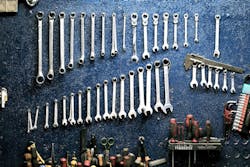In 2017, KPMG Corporate Finance presented an extensive evaluation of the insurance industry after another year of difficulty underwriting profitable insurance business and dubbed the phenomenon “the chaotic middle.” That is to say, the next 10–15 years will bring about an unprecedented level of technology, competition and new mobility disruptors that will change shop-insurer relations.
That requires a shift in other segments of the industry, as well, including I-CAR. In 2018, the organization launched changes to its training programs and curriculum, including a three-level insurance adjuster and appraiser training.
FenderBender sat down with Brad Gutcher, manager of development insurance at I-CAR, and discussed some of the new I-CAR training for insurance adjusters (known as auto physical damage adjusters) and possible future impacts of insurance company relationships with OEMs.
How is I-CAR involved in the insurance industry?
Not only do collision repair technicians need to be trained on basic and advanced repair procedures and materials going into these new cars, it’s also just as vital that the insurance adjuster be up to date.
They may not know how to do the repairs but they need to understand how the repair should be conducted. This allows them to be on equal footing with the repair shop. So that’s one aspect of how we work with the insurance industry, which is in the training of their adjusters. We refer to adjusters as auto physical damage adjusters (APDAs).
How many hours does each level of insurance adjuster training comprise of?
The first level, ProLevel 1, is comprised of 10 three-hour online courses, totaling 30 hours of training. ProLevel 2 incorporates another 30 hours worth of training and ProLevel 3 is the final training stage.
What are the big changes for insurers that will affect the industry in the next 5–10 years?
There’s a lot on the horizon, at some level. One is the use of artificial intelligence in remote diagnostic systems or telematics that develops an estimate after a collision. It’s filed and automatically transmitted to the OEM, which will file a claim for the insurer and dispatch towing and also suggest to the customer where to have their car taken. If it is the OEMs controlling that, they’re going to want to take the car to a certified repair shop.
This taking control of the first notice-of-loss process away from the insurer will be a game changer for them.
With OEMs selling their own insurance right at the dealerships and also autonomous vehicles, the underwriting of that will definitely change the policies. We’re seeing that already in the manufacturing of semi-automobiles.
On the insurance end, what will look different for an insurer and how will that eventually lead to first contact of collision repair shops and how they set up the repair?
If the OEM does sell its own insurance and there is a partnership, that would create competition between the OEM and the insurance carrier’s business on a macro account. There would be a huge change in the insurer’s business model. There’s a lot of regulations on the insurance industry. But for the most part, OEMs do not need to worry about when the repairs need to be done and you can’t do that when you’re an insurance company. That would change as far as training goes. The OEM would need either an in-house adjuster or have their estimators become adjusters.
As far as repair procedures, there would be good blending of the remote diagnostic systems coming into the insurer so they have that near real-time estimate. It can be validated when a car goes into the shop. That would speed up the whole repair cycle from key to key.
How many people participate in the training you offer?
In 2015, we had roughly 5,400 platinum adjusters, which was about 19 percent of the appraisal population. This year, we have grown to 8,200 and the number of adjusters fluctuates each year, so that is about 50 percent of the population now.
We expect it to grow. There is the opportunity to gain H200 Plus and then become a corporate Gold Class company. To become Gold Class [recognized], you need 60 percent of the adjusters to reach Platinum or ProLevel 1. Right now, there are about 19 in total out of all the large companies, which include Nationwide, Allstate, State Farm and USAA.



